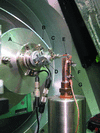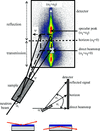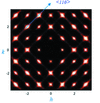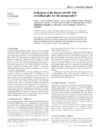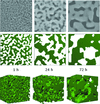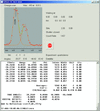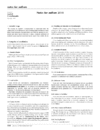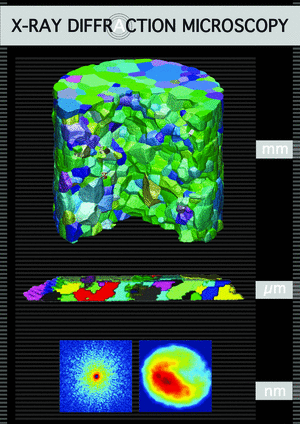issue contents
February 2011 issue

Cover illustration: Selected images of optical birefringence recorded during the heating of dodecasil-3C crystals. Courtesy of Lethbridge et al. [J. Appl. Cryst. (2010), 43, 168-175].
research papers
A conventional X-ray diffractometer was equipped for energy-dispersive diffraction and applied to depth-resolved residual stress analysis. The results obtained under laboratory conditions are in good agreement with measurements performed using synchrotron radiation.
The Rietveld method is based on a weighted least-squares fit of a model diffraction pattern to the step-scan data of a complete experimental X-ray or neutron diffraction pattern. As the most commonly used weights lead to a biased background estimate, an alternative method for refinement of Poisson-distributed experimental data is proposed that involves only changes to the input data and the weights of least-squares refinement.
Three different approaches to a total quantitative phase analysis including all crystalline and amorphous phases of a three-component organic mixture are developed. These approaches are an extension of the external standard method introduced previously.
A multicomponent calibration approach is presented and demonstrated, which can be used to reduce systematic bias in quantitative phase analysis. This approach offers practical advantages over the Brindley correction for microabsorption.
The quality and properties of simple iterative desmearing procedures – the Lake algorithm and the Van Cittert desmearing routine – have been tested by introducing different convergence criteria using both calculated and experimental small-angle neutron scattering data.
Supercritical carbon dioxide within a porous silica aerogel behaves as a two-phase system formed by a film next to the silica walls and a remaining fluid phase. Small-angle neutron scattering allows one to determine the structural parameters of the involved phases.
SMTK, a small-molecule toolkit library for crystallographic modelling and refinement, is described.
Peak splitting observed in powder diffraction patterns collected during crystallization experiments was attributed to sample displacement arising from crystallites forming on the capillary walls rather than in the bulk of the capillary volume. A correction for this displacement is presented.
The results of X-ray topographic studies of diamonds using allowed and forbidden reflections are presented. The contributions of several types of point and extended defect to the image formation are evaluated.
Angle calculations are presented for a (2+3)-type diffractometer in the vertical and horizontal geometry, focusing in particular on some special aspects when using area detectors.
The structure of a diblock copolymer thin film at various film depths, from the substrate–polymer interface through the film bulk to the polymer–air interface, is simultaneously probed in a single measurement using the time-of-flight grazing-incidence small-angle neutron scattering technique. By utilizing the material characteristic Yoneda peak position parallel to the normal of the polymer film, information about the enrichments at both interfaces with one or the other block is gained.
Small changes in atomic coordinates caused by internal stresses in doped nonlinear optical crystals are investigated. Invariant triplet phases are measured via X-ray multiple diffraction experiments.
High-throughput synchrotron powder diffraction analysis on beamline I11 at Diamond is described. This is used to study a series of Fe-doped lanthanium nickelate nanoceramic materials produced by a high-throughput automated continuous hydrothermal flow reactor.
B-site 〈110〉 displacements have been observed in the high-angle annular dark-field images of PbMg1/3Nb2/3O3 and PbZn1/3Nb2/3O3 recorded via a Cs-corrected scanning transmission electron microscope.
Necking and subsequent step growth processes in LiF single crystals grown by the Czochralski method were found to be very useful for growing good quality crystals. The observed correlation of the investigated physical properties of optical transparency, photoluminescence and dielectric properties with the crystalline perfection is discussed.
Broadband terahertz time-domain spectroscopy and imaging have been used to measure the absorption of protein single crystals. A dehydration study of tetragonal hen egg white lysozyme is presented as a proof of concept.
The principles and application of three-dimensional pair distribution function techniques for analysing disorder based on diffuse scattering are presented and illustrated using the example of disorder in decagonal Al65Cu20Co15.
A synchrotron tomographic energy-dispersive diffraction imaging study of the aerospace alloy Ti 6246
Tomographic energy-dispersive diffraction imaging (TEDDI) has been extended to high X-ray energies using a white-beam source on I15 at Diamond together with a CdZnTe detector. The TEDDI system was used to nondestructively characterize a linear friction weld in an aluminium alloy workpiece used for aerospace applications.
The formation of black LiTaO3 single crystals through chemical reduction is found to be due mainly to the change in the chemical state of Ta. Evidence of oxygen vacancy creation during chemical reduction has also been obtained.
Synchrotron-based X-ray diffraction microtomography was used to study simultaneously the phase distribution and microstructure of phase-transformation processes. This three-dimensional non-invasive imaging approach has been applied to understand the phase transformation of C60 rhombohedral polymer into disordered graphite at high pressure and high temperature.
This paper describes the use of poly(ethylene) oxide as an organogelator and its application in crystallization in gels with organic solvents.
A new method to determine the energy-dependent variation of the X-ray flux of a synchrotron beamline based on the comparison between observed intensities and the calculated intensities of a well known structure has been developed.
This work defines the crystallinity of cellulose I materials on a dry-weight basis.
The ab initio phasing algorithm VLD has been modified and applied to small- and medium-size structures and to proteins.
Ultra-small-angle X-ray scattering-based X-ray photon correlation spectroscopy (XPCS) is developed to probe long-time-scale equilibrium or non-equilibrium dynamics in a scattering vector range between those of dynamical light scattering and conventional XPCS.
short communications
Download citation


Download citation


Open  access
access
 access
accessAn evaluation of the Bruker SMART X2S for the collection of crystallographic diffraction data, structure solution and refinement is carried out with a variety of materials with different electron densities, presenting some of the successes and challenges of automation in chemical crystallography.
A recent revision of the elastic constants for α-Al2O3 (corundum) has been verified on the basis of diffraction elastic constants measured by neutron diffraction from a solid polycrystalline sample under applied uniaxial stress.
computer programs
The program DiffractWD provides tools for powder pattern visualization and analysis.
SAXSMorph is a useful program for obtaining three-dimensional representative morphologies from small-angle X-ray and neutron scattering data. It is user-friendly stand-alone software that can be used in a variety of software environments.
A new interface for Jmol has been developed, called J-ICE, for handling and visualizing crystallographic and electronic properties entirely via a web server, i.e. without the burden of installing complex packages. J-ICE can also be employed as an import/export tool, to transform universal CIF or Protein Data Bank structure files (from experiment or previous calculations) into an input format compatible with programs such as CRYSTAL09, CASTEP, QUANTUM ESPRESSO and VASP.
A computer program is developed for solving crystal structures from powder diffraction data using models generated by an equivalent position combination algorithm based on unit-cell content and space-group information.
Open  access
access
 access
accessMoleCoolQt is a molecule viewer designed for experimental charge density studies with a user-friendly graphical user interface.
Computer-based tools for inferring single-crystal stuctures and fibre textures from two-dimensional diffraction diagrams are presented.
SINGLE, a Windows program, can be used to control a variety of four-circle Eulerian-cradle single-crystal diffractometers including Hubers, the Stoe Stadi-4 and the Siemens P4.
laboratory notes
Capillaries inserted in a concentration gradient of NiCl2 act as suppressors of excessive nucleation, so that crystals of hen egg-white lysozyme of more than 2 mm in the longest dimension can be obtained regardless of its commercial origin.
international union of crystallography
Free 



 journal menu
journal menu
















